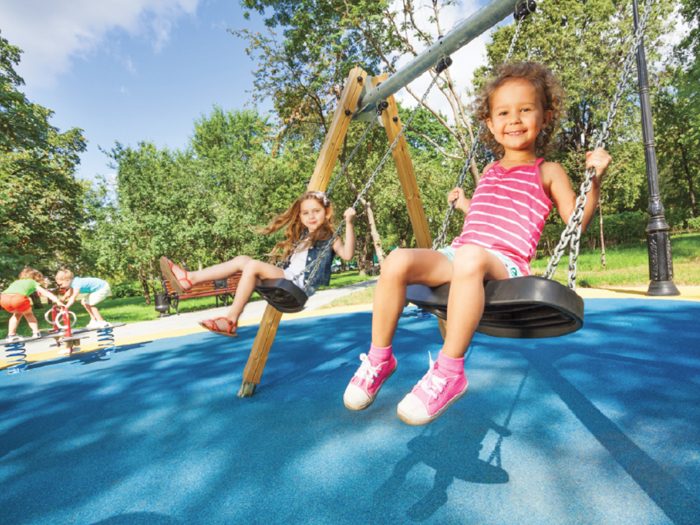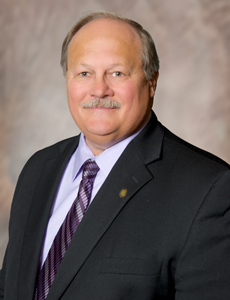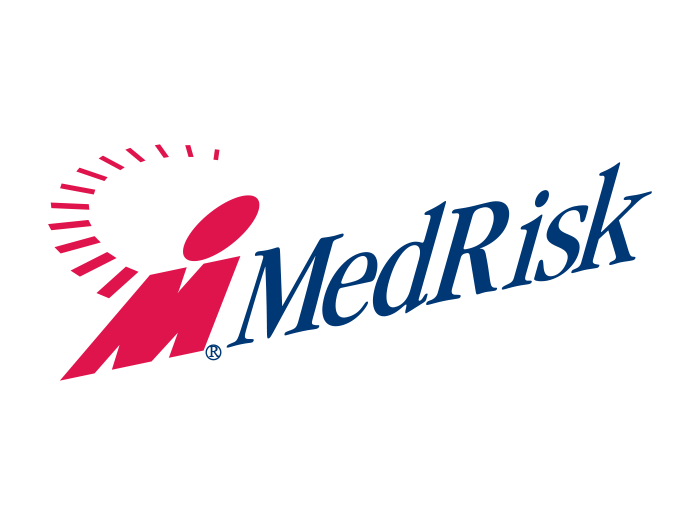Public Sector Safety
Safe Places for Risky Outdoor Play

Children inevitably suffer cuts, scrapes and other “boo-boos” in the course of swinging, sliding and climbing, but many of the 200,000 annual emergency room visits from playground accidents are preventable, according to insurance and playground experts.
Many factors contribute to eliminating known hazards so children can stretch their wings as safely as possible.
Best practices include ensuring good sight lines for supervisors, isolating bigger kids from toddlers to avoid collisions, soft surfacing under equipment, sound S-hook connectors on swings, the elimination of head and torso entrapments, coatings to seal splinters, signage to alert caregivers to remove the strings from hoodies that can result in strangulation … the list goes on.
Even with the most vigilant design and maintenance, though, “we can’t and shouldn’t eliminate all risk,” said Bill Hooker, risk manager and training program supervisor, Park District Risk Management Agency in Chicago.
“Even if we could, no child would ever want to play in a risk-free playground.”

James D. Smith, director, risk control services, Arthur J. Gallagher & Co.
A playground cleansed of hazards — no moving parts or heights to fall from, for example — may be so boring that resourceful children will use the equipment in a manner the manufacturer never intended, said James D. Smith, director, risk control services, Arthur J. Gallagher & Co.
“Children make up their own games on equipment, and then you have new dangers you can’t plan against.”
This creativity calls for close supervision, Smith said.
The way a community regards its playgrounds, the kind of apparatus it provides and the diligence with which it inspects and maintains them, awakens philosophical questions, said Kenneth Kutska, executive director, International Playground Safety Institute LLC.
“We ask, ‘What is our goal?’ That starts a discussion about what risk is acceptable.” On the one hand, he said, play teaches critical developmental skills, with the risk of injuries along the way.
“If we take the risk out of playgrounds, we also take out the challenge and learning opportunities. When our primary goal is to meet financial goals, we fail our children.”
Minimal Legal Oversight
Communities benefit from the multitude of programs and standards that eliminate known hazards, said Timothy L. McCarty, risk control manager for Trident Public Risk Solutions.
These include the Consumer Product Safety Commission’s “Public Playground Safety Handbook,” which gives guidance on safety features such as shock-absorbent surfacing materials and safe arrangement of equipment; the American Society for Testing and Materials’ voluntary consensus standards on age-appropriate equipment, fencing, sight lines and recommended outerwear, among many other hazards; and The National Recreation and Park Association’s Playground Safety Inspector Certification.
While these programs offer “great guidance,” said McCarty, they are not law. Only 15 states regulate playgrounds. Only California, with the most robust oversight, mandates inspections. “It’s not illegal in most places to have uninspected playgrounds,” said McCarty, which puts children and communities at risk.
We can’t and shouldn’t eliminate all hazards. Even if we could, no child would ever want to play in a risk-free playground. — Bill Hooker, risk manager and training program supervisor, Park District Risk Management Agency.
Maintenance failures are the single greatest risk of loss and credibility, said Kutska, contributing to 40 percent of injuries. The other major contributors are noncompliant surfacing, failure to train or hire trained inspectors, failure to document inspections and corrections, and inadequate supervision.
Municipal and school district liability varies from state to state, said Thom Rickert, vice president, head of marketing, Trident Risk Solutions, and some states have immunity laws for owner-operators of recreational spaces. New York City has municipal regulations that require adults to be accompanied by a child to keep predators away. “Liability depends on the venue,” he said.
Heavy Wear and Tear
About 75 percent of nonfatal injuries related to playground equipment occur on public playgrounds, according to the Centers for Disease Control and Prevention, and most of those occur at schools and daycare centers — which have far fewer certified playground inspectors on staff than municipal parks, said AJG’s Smith.

Thom Rickert, vice president, head of marketing, Trident Risk Solutions
School playgrounds get a disproportionate share of wear and tear, said Greg Hennecke, risk management representative, Hylant Administrative Services, and spokesperson for the National Recreation and Park Association as well as one of its certified playground safety inspector instructors.
They’re used hard for the three-odd hours of recess on the 180 days per year school is in session, then do double duty after school and on weekends, especially in communities where municipal parks are scarce.
“That puts more pressure on school districts to maintain them,” he said.
How much use a playground gets is one of many factors driving the frequency of inspections, Hennecke said. The insurer also considers whether the state has sovereign immunity laws. Exception clauses to the laws, which may strip immunity in the presence of physical defects, should put yet more emphasis on maintenance programs.
Current design standards are much different, and much safer, than they were 15 to 20 years ago, when wood parks with elevated ramps and turrets were the style, but they splintered and cracked as they aged. “Most installers know and adhere to the standards we inspect against,” said Smith.
Layout is also important, such as allowing sufficient room between the shoot of a slide or a swing and the next piece of apparatus or a fence. In addition, the composite material from which most equipment is now built stands up to weather and very hard wear better than the wood and metals of yore.
To minimize injuries and liability, Hooker recommended a “diamond of care” — four interrelated steps that together identify and minimize safety hazards:
1) Knowledge of standards and best practices.
2) Inspections by trained inspectors.
3) Corrections, including routine and preventive repairs, and if necessary, removal of hazardous equipment.
4) Documentation of action taken.
Surfacing Materials Matter
Falls onto hard surfaces account for about half of the injuries serious enough to warrant an emergency room visit, according to the CDC, but a serious injury doesn’t necessarily call for removal of the apparatus from which the child fell, Smith said.
Although removing the apparatus will remove its risk and liability, he said, the better option is more and better absorbing material, such as wood chips, gravel, sand, rubber pads, bark mulch or engineered wood fiber. In several cases, families claim “spinning disc” rides threw their toddlers to the ground, which wasn’t buffered by absorbing material.
“Insufficient surfacing material is the direct reason we have more serious injuries,” said Kenny Smith, risk control manager, OneBeacon Government Risks. He often sees “big divots” scooped out under swings.
Many entities, such as the Richland (Washington) School District, are removing swings from playgrounds on the advice of their insurance carriers but also because they use space inefficiently.
Experts said large modular play structures, or even a “return to nature,” installing big rocks with absorbent materials as flooring, are more efficient yet fun uses of playground space. &










